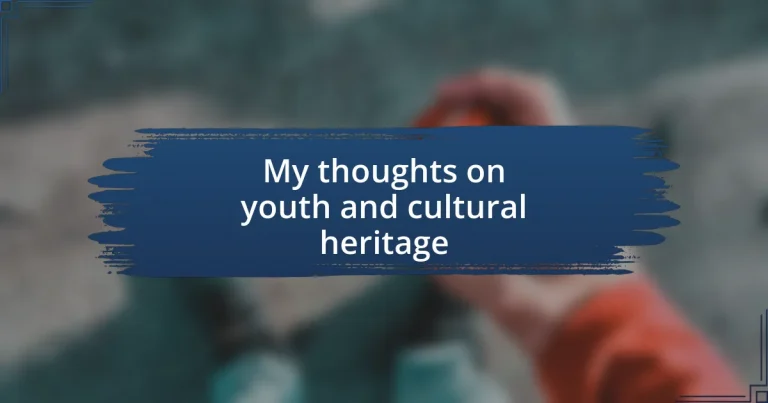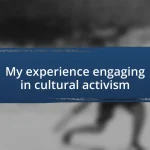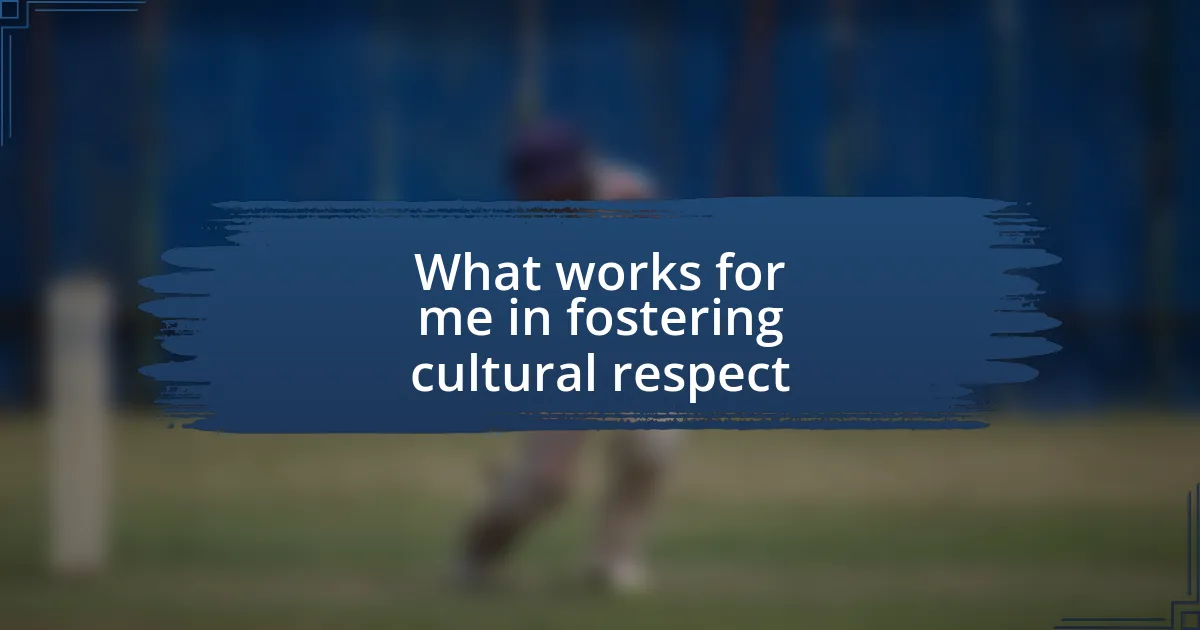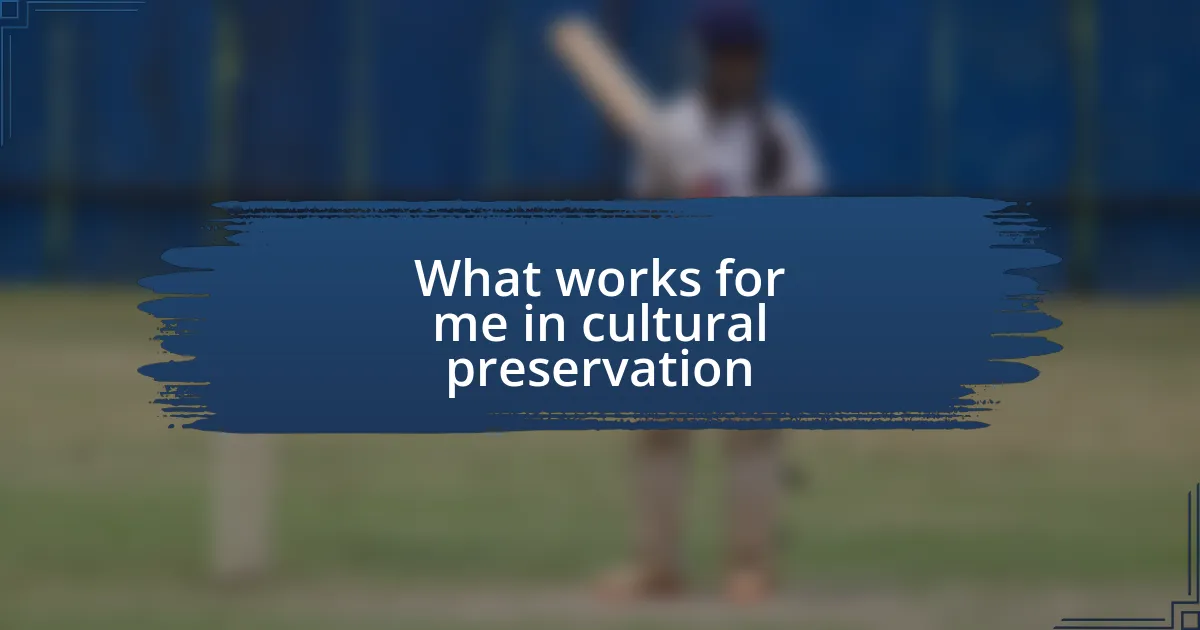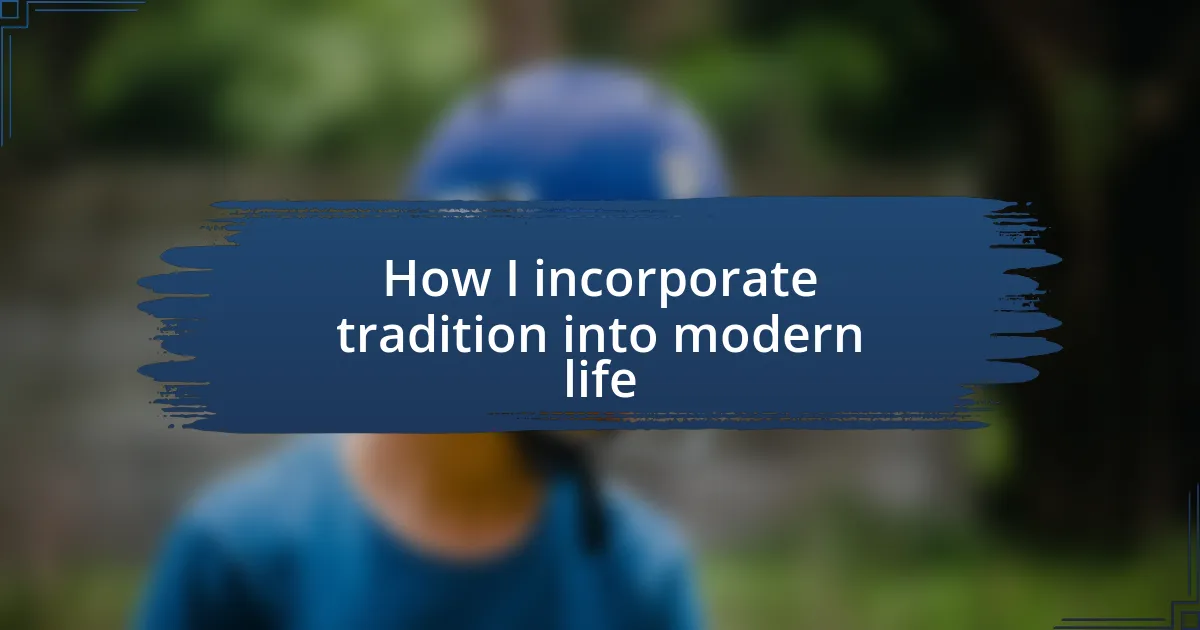Key takeaways:
- Cultural heritage connects generations and fosters community identity, promoting a sense of belonging through shared experiences.
- Youth engage with traditions by adapting them for modern contexts, utilizing social media, mixing musical genres, and organizing cultural festivals.
- Education plays a vital role in preserving cultural heritage by incorporating traditional stories and hands-on workshops, enhancing pride and connection among young people.
- Technology serves as a powerful tool for cultural preservation, enabling digital storytelling, virtual reality experiences, and the archiving of endangered languages.
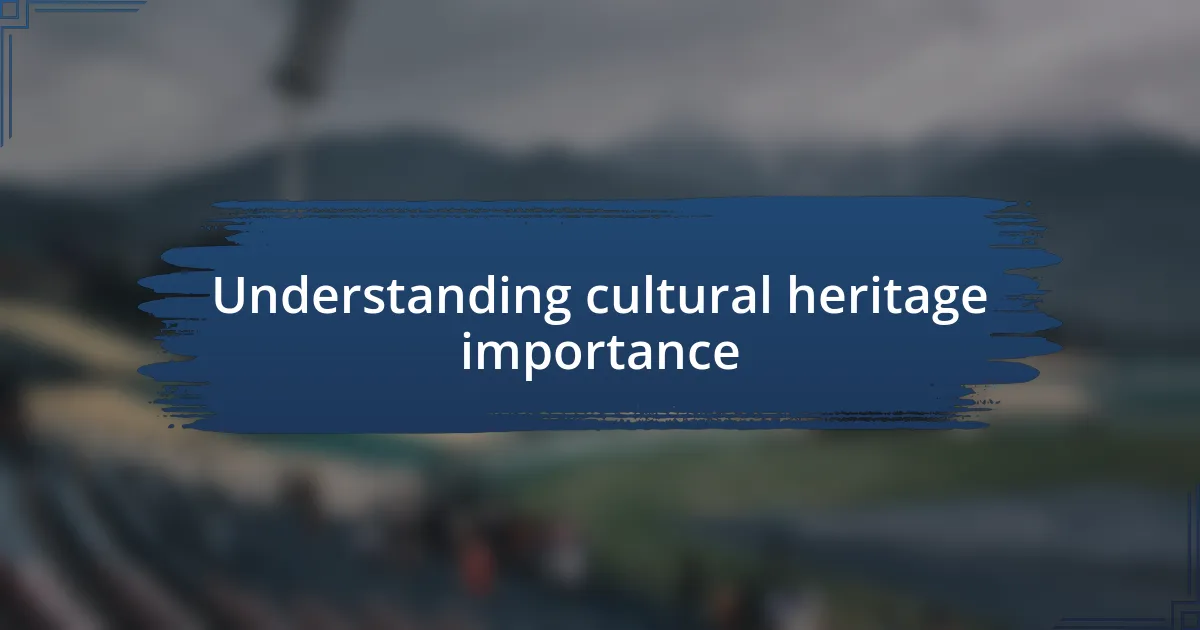
Understanding cultural heritage importance
Cultural heritage serves as a bridge connecting generations, allowing us to understand our roots and share stories from the past. I remember visiting my grandmother’s village, where the old tales and traditional crafts seemed to echo through time, teaching me that these elements are not just forgotten relics but living parts of our identity. This experience made me wonder: how can we nurture these stories to ensure they thrive in a rapidly changing world?
Preserving cultural heritage is crucial because it shapes our community’s identity and fosters a sense of belonging. I once attended a local festival that celebrated our community’s unique traditions, and it struck me—seeing everyone come together, sharing laughter and food, created a profound sense of unity. Doesn’t it make you think about the way our shared experiences can strengthen our bonds?
Moreover, the importance of cultural heritage extends beyond personal connections; it influences our global perspective as well. I’ve noticed that when we embrace and celebrate diverse cultures, we cultivate empathy and understanding towards one another. Isn’t it fascinating how engaging with different heritages broadens our worldview and allows us to appreciate the richness of human experience?
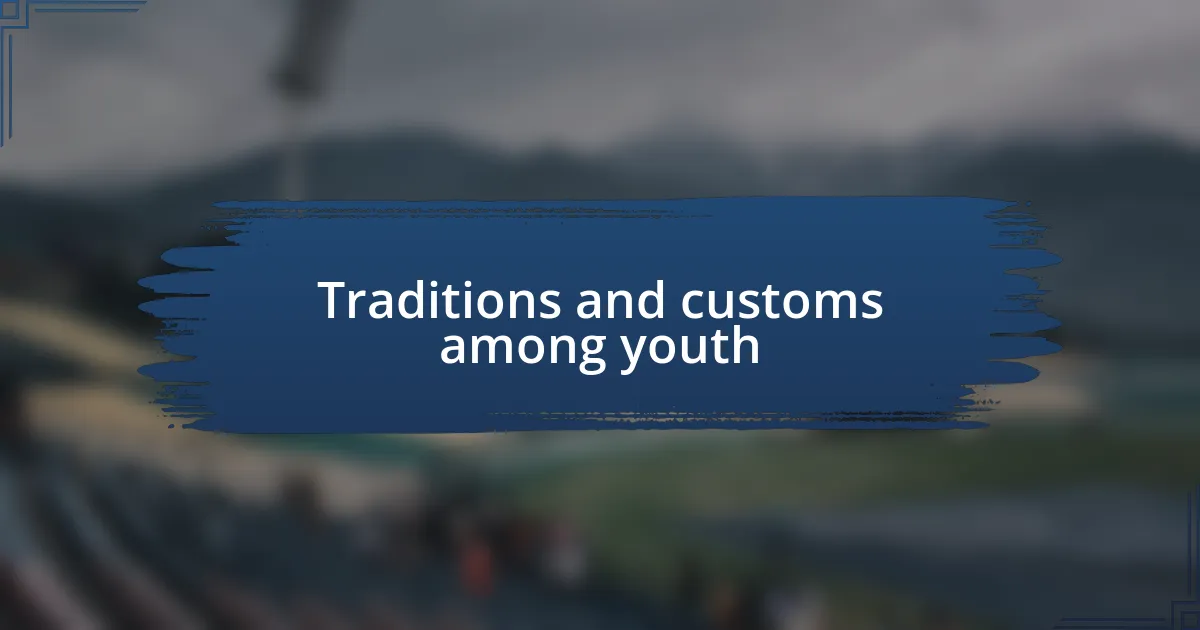
Traditions and customs among youth
Traditions among youth often manifest in vibrant and unique ways, showcasing their ability to adapt and redefine customs for modern contexts. For instance, I recall attending a friend’s wedding where they infused traditional rituals with contemporary elements, like a live DJ blending folk music with current hits. This blending not only preserved the essence of the ceremonies but also resonated deeply with our generation, highlighting how we can cherish our heritage while embracing innovation.
Here are some traditions and customs that I’ve observed among the youth:
- Social Media Celebrations: Young people often share cultural festivities online, showcasing traditional clothing, foods, and practices through platforms like Instagram or TikTok.
- Mixing Genres in Music: There’s a trend of blending traditional musical styles with contemporary genres, keeping age-old customs relevant and engaging.
- Community Workshops: Many youth participate in workshops to learn traditional crafts like pottery or weaving, connecting with their history while fostering creativity.
- Cultural Festivals: Younger generations actively organize and participate in multicultural festivals, celebrating the diversity within their communities and promoting understanding.
- Storytelling Circles: I’ve seen friends gather in informal settings to share personal family stories related to cultural practices, reinforcing identity and connection.
Such practices reflect the dynamic interplay between tradition and modernity, showing that youth can effectively honor their cultural heritage in ways that resonate with their values and lifestyles.

Promoting engagement through education
Promoting engagement through education is essential in nurturing a deep appreciation for cultural heritage among youth. I remember volunteering at a local school where we introduced a curriculum focused on traditional stories and folklore. The excitement on the children’s faces when they connected with characters from their culture was unforgettable; it taught me that education can bring history to life when done creatively.
Another experience that stands out to me is when I attended a workshop designed for young people to explore traditional crafts. The energy in the room was contagious as participants learned to weave and create intricate designs that reflect their ancestry. It became clear to me that hands-on engagement fosters not just skills, but also a sense of belonging and pride in one’s roots.
Furthermore, I’ve observed how digital platforms can complement traditional education methods. Online courses that incorporate elements of cultural heritage have allowed youth from diverse backgrounds to share their knowledge and perspectives. I’ve seen peers excitedly collaborate on projects that celebrate their heritages, proving that education can transcend boundaries and build connections.
| Engagement Method | Description |
|---|---|
| Interactive Workshops | Hands-on experiences that teach traditional crafts and stories. |
| Online Platforms | Digital courses and social media that promote cultural sharing and learning. |
| Cultural Events | Community festivals that celebrate and educate about diverse heritages. |
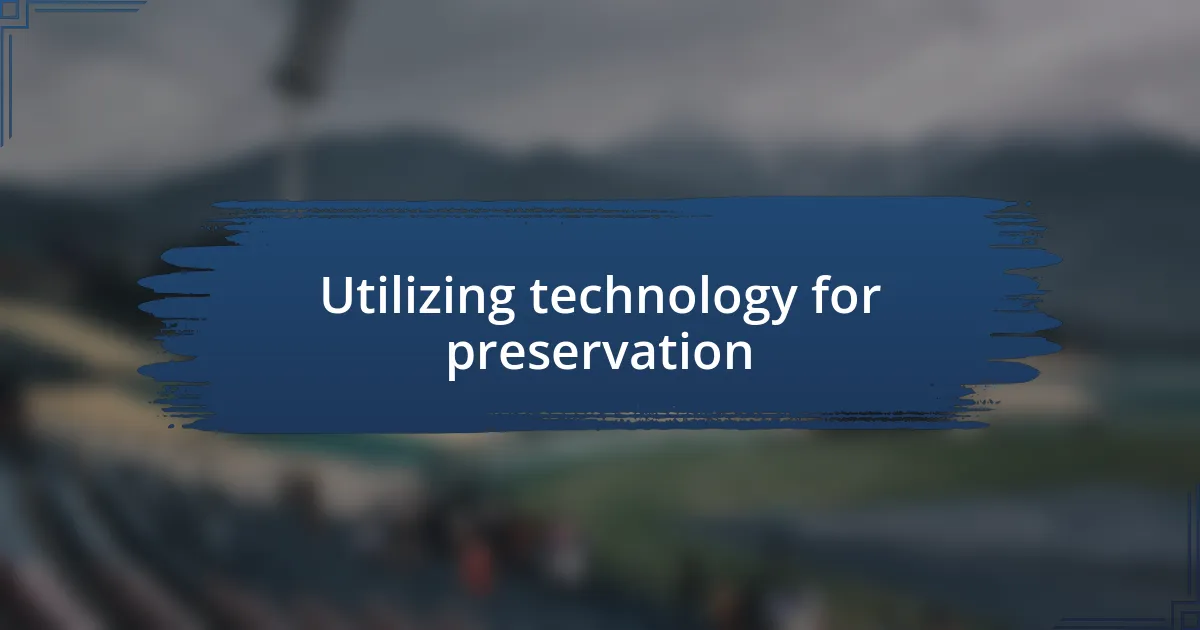
Utilizing technology for preservation
Embracing technology for cultural preservation can be truly transformative. For instance, I once participated in a virtual reality (VR) project that reconstructed historical sites from my community. Experiencing these places in a digital space felt like stepping back in time; I could almost hear the whispers of the past, which made me ponder how powerful technology can be in keeping our heritage alive.
Additionally, I have seen how social media platforms become invaluable tools for sharing stories and traditions. A friend of mine launched a series of short videos that showcased local art forms, revealing techniques gathered from generations. It was inspiring to witness how these digital expressions not only reached wider audiences but also reignited pride within our community; who wouldn’t feel connected when they see their culture celebrated online?
Finally, I often reflect on how archives and databases using artificial intelligence can assist in preserving languages at risk of disappearing. I remember reading about an initiative that digitally archived recordings of native speakers telling traditional tales. The realization that future generations could still hear these voices made me hopeful—technology isn’t just a tool; it’s a lifeline for our cultural narratives, breathing life into them for the young and curious.
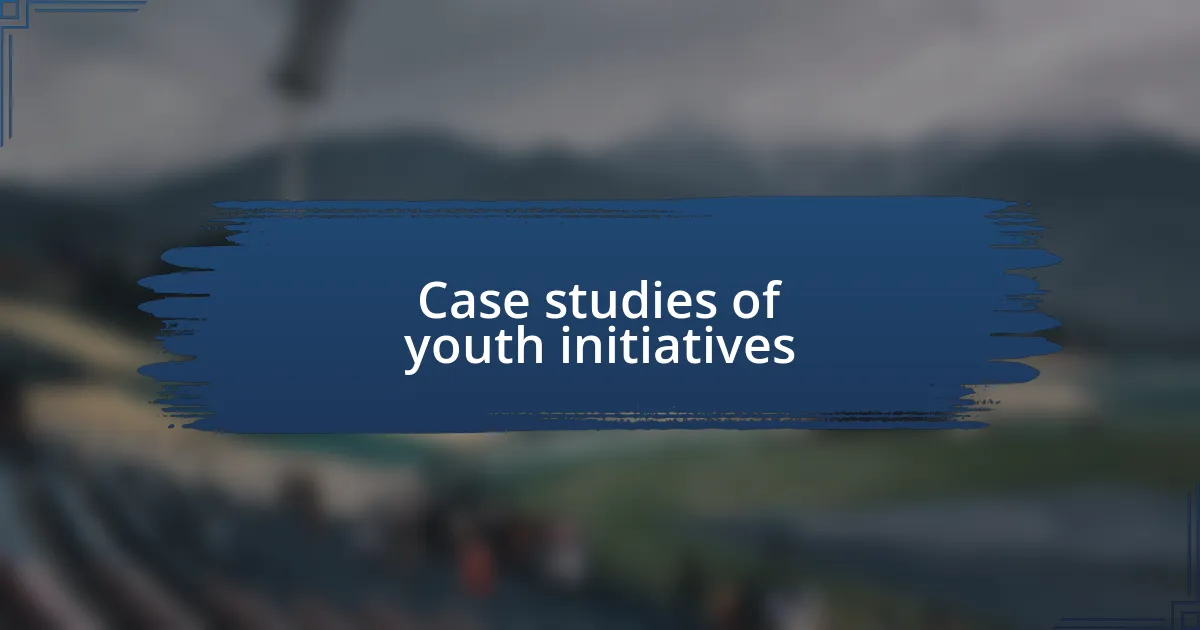
Case studies of youth initiatives
One compelling case study that stands out in my mind is a local youth-led initiative focused on reviving traditional crafts in our region. Young artisans organized workshops, bridging the gap between generations by teaching skills like pottery and weaving. I remember participating in one of those sessions and feeling the warmth of shared knowledge; it was as if each crafted piece told a story, connecting us to our ancestors in a tangible way.
Another initiative I encountered was a vibrant theater group comprised entirely of teens from diverse backgrounds. They created plays that revolved around cultural themes and historical narratives from our community. While attending one of their performances, I was struck by the emotions they conveyed; it was a powerful reminder that storytelling remains a profound tool for cultural transmission. What better way to engage youth than to let them express their heritage through the arts?
Lastly, there’s a digital campaign aimed at documenting and sharing local folklore, led by a group of enthusiastic young writers. They collaborated with community elders to collect and share these treasured stories online. Reflecting on my experiences with this initiative, I can honestly say that it not only preserved my culture but also made me consider: can these stories transcend time? It’s a comforting thought that through the passion of youth, our heritage can continue to inspire and unite us.
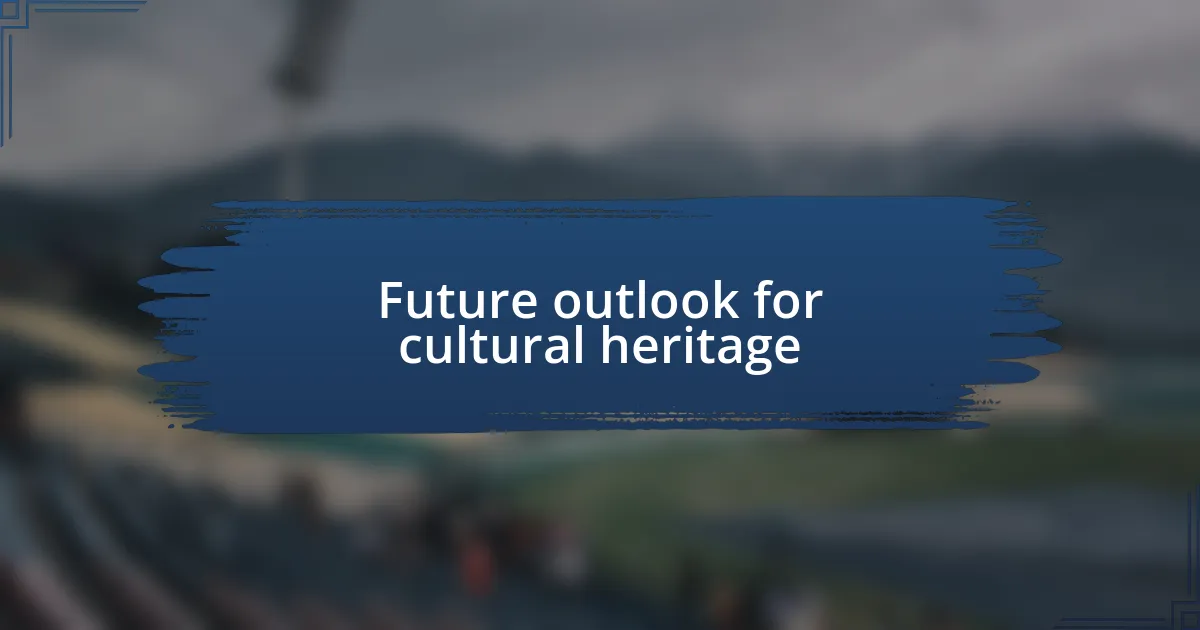
Future outlook for cultural heritage
Looking ahead, I see cultural heritage taking on new forms, particularly as technology continues to advance. I remember my first experience with virtual reality; it opened my eyes to the possibilities of exploring historical sites from my living room. How incredible is it that future generations could interact with their heritage in immersive ways, enhancing both understanding and appreciation?
Additionally, the rising influence of social media means that cultural expressions can reach a global audience with unprecedented speed. I often think back to how one post showcasing a traditional dance immediately sparked interest and dialogue around our local traditions. This potential for cross-cultural exchange invites a richer tapestry of shared heritage, but it also poses the question: how do we maintain authenticity while embracing modernity?
Ultimately, I believe the future of cultural heritage hinges on collaboration between youth, technology, and traditional custodians. I fondly recall discussing ideas with friends about how to blend old rituals with contemporary practices. This dialogue not only keeps our heritage alive but also transforms it, ensuring that it evolves while still honoring the past. What legacy do we want to pass on, and how will we safeguard it for those who come after us?
